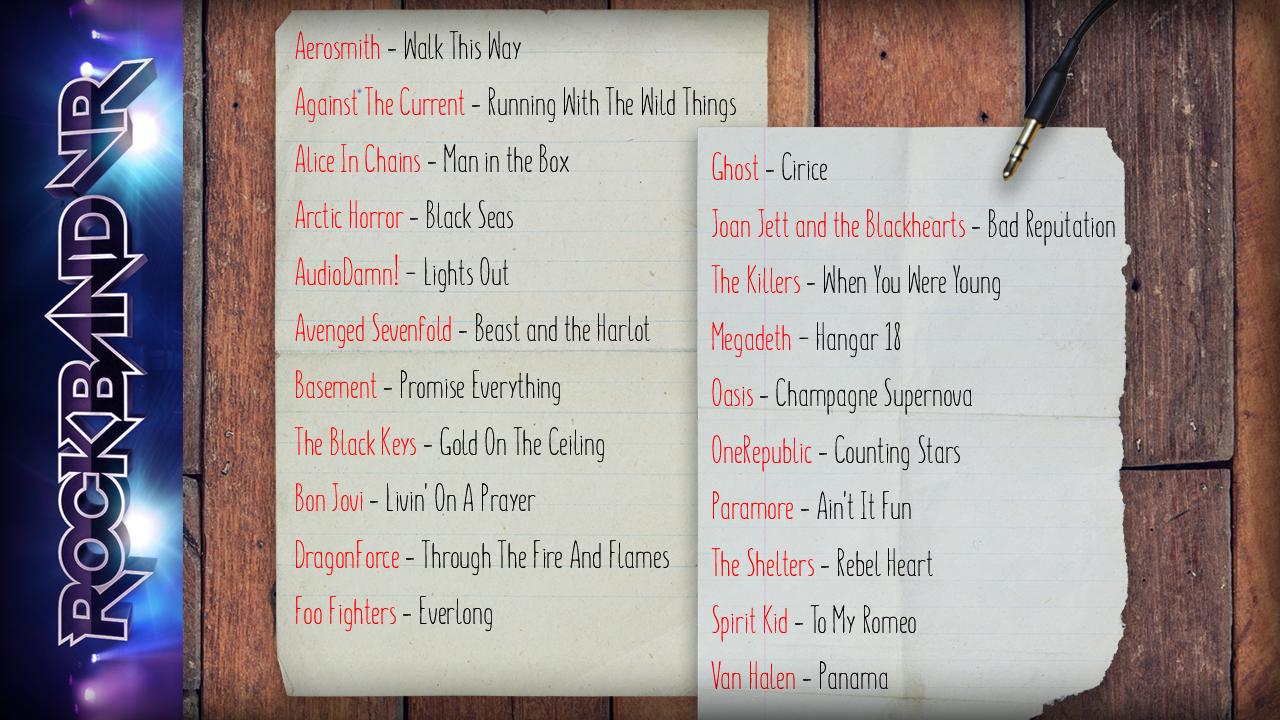




New songs have been revealed as part of the core Rock Band VR soundtrack, consisting of 60 songs! On March 23rd, be prepared to step on stage and bring the house down with these tunes:
Keep an eye out, some of these songs will be hitting Rock Band 4 in the future as DLC.
Need some gear to rock in virtual reality? Save more than $20 compared to standalone pricing when you pre-order your Rock Band VR Guitar Controller Bundle on Amazon Now!
That’s not all, folks! These tracks are not the only ones coming in the core soundtrack of Rock Band VR. There are 39 remaining songs that have yet to be announced, and we know you’re craving for more. Want to be the first to feast your eyes on the new tunes? Follow @RockBand on Twitter and give us a like on Facebook for the latest in Rock Band and Rock Band VR announcements!
Want to learn the ins and outs of how scoring works in Rock Band VR? Then we’ve got a blog post for YOU. Resident designer Greg LoPiccolo is here to break it down.
As Creative Lead of Rock Band VR, I am excited to finally get an opportunity to talk about what we’ve spent the last two years building. We have shown versions of RBVR to the press and public since about last March, and while players have had a blast just being onstage, we have gotten consistent questions along the lines of “How do you score? Will there be leaderboards? How challenging is it?” It’s time to answer those questions! This is going to be a deep dive, so buckle up!
Early in development, we decided that the traditional Rock Band note highway was not an ideal experience in VR. It actually minimizes the best parts of VR by requiring that you spend all your time staring at one fixed point in space, the note chart, instead of being present onstage with your bandmates in front of a crowd. We knew we wanted to create an experience that feels more like an actual performance – and we’re really proud of what we developed. The key is this fundamental gameplay difference: instead of “unmuting” the original recording in response to correct play, like in traditional Rock Band, RBVR gives you the power to generate a new guitar part. The game takes care of keeping you in tune, so whatever you play sounds good, but you have a LOT of control over the sound of your part – so you don’t need to stare at one point in space.
Rock Band VR has three skill levels (i.e., difficulties) in: Rock Star, Virtuoso and Monster, but before we get into that, let’s start with the basics.
In RBVR, if you hold down a unique combination of fret buttons and strum, you get a unique guitar sound that matches the song. Here are the kinds of guitar sounds you can get out of RBVR, with their associated fret button mappings, each of which lights up your fret buttons with its own color. We call these Chord Shapes.

We’ve done a lot of work to ensure that these all sound good whenever you play them, but they give you a range of sonic possibilities that let you tailor your performance to suit your own taste. In Freestyle mode (available in Quickplay), you can just explore these sounds to your heart’s content, with no scoring pressure.
In Rock Star Mode, you need to organize chords into simple patterns as you play. The closest analogy to other games is the trick system in skateboard and snowboard games, whereby you need to chain tricks together for score. As an example, the simplest pattern you may attempt is alternating between two chord shapes in the form: ABAB. We call these patterns Combos. Note that both A and B can be any of the supported chord shapes to form the Alternator combo. Other supported Combos include:
You also have the ability to play these combos at three different lengths: Normal, Mini, and Mega. For instance, sometimes it makes sense to play a Mini to fit an extra combo into a song section that won’t accommodate a Normal combo. Some other details about Rock Star scoring:
It’s a complex system that takes some getting used to, but it feels amazing to have this much control over your sound – it is the most responsive music gameplay that we have ever developed. Once you have mastered all the ins and outs of the Rock Star skill level, it is time to graduate to…
Virtuoso Mode starts with all the combo-forming gameplay that is present in Rock Star, and adds another layer of connection to the music (and challenge!). In Rock Star mode, the chord shape that you form can be on any fret buttons; so, for instance, you can play a bar chord shape by pressing Green/Red/Yellow, Red/Yellow/Blue, or Yellow/Blue/Orange.

In Virtuoso Mode, every time there is a chord change in the song you are playing, you need to shift your hand position in response to the chord change. We call these shifts Chord Follows.
The real challenge of RBVR play is executing the Chord Follows while you form combos. In some songs, it’s not too difficult, but by the time you get to the songs at the end of the campaign, you’ll be working up a sweat. It is also crazy fun, and does an amazing job of pulling you into the song. Once you have mastered Virtuoso Mode, it’s time for…
Monster Mode is easier to describe now that you have a handle on the other modes. There are some nuances that are outside the scope of this post – Monster Mode is basically Virtuoso Mode without the visual cues from the song map; you have to form the combos and hit the Chord Follow cues without any visual guide; just by knowing the song. It’s tough! The magic of it starts to emerge when you realize that you can just look out at the crowd, or at your bandmates, because you KNOW THE SONG, just like actual rock guitarists know their songs without having to sight-read them. If you can hack Monster Mode, you are a Rock Band VR legend.
There are some other unique scoring features, specifically around Solos and Overdrive, but we’ll save them for another post!